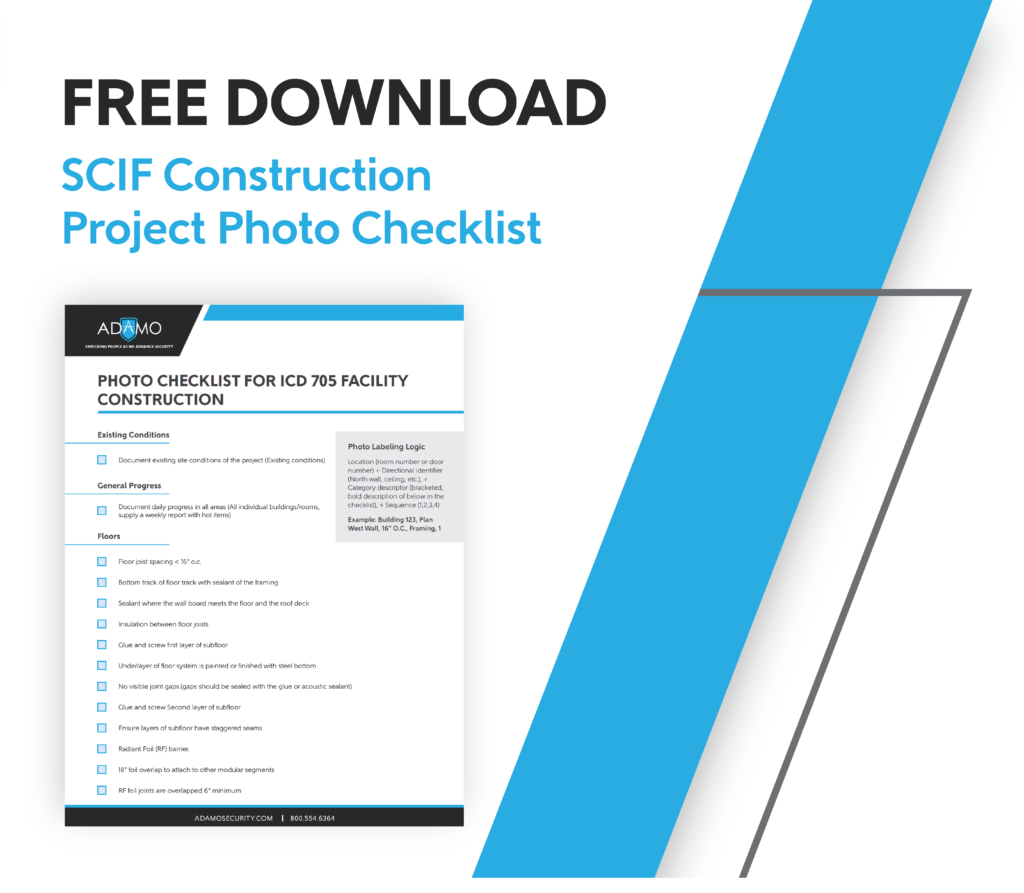An overview of STC mitigations and sound masking
Secure facilities like SCIFs and SAPFs need to meet a certain standard of acoustic protection, measured in a Sound Transmission Class (STC) rating. The ICD 705 Technical Specifications, or Tech Spec, necessitates a minimum of STC 45, though you may face higher requirements based on your facility’s specific vulnerabilities and the recommendations of the Accrediting Official (AO).
However, when the facility is complete, the perimeter may sometimes fail to meet requirements after acoustic testing. In these cases, there are mitigations you can implement that will still make human speech unintelligible to people outside the facility. These mitigations can be a quicker and easier fix than redoing the walls and can prevent an extension to your timeline or an increase in your budget.

Sound Masking Overview
Sound masking is a form of mitigation where you add extra protections to prevent sound from escaping your facility. It may cover-up sound with white noise or disrupt sound waves and prevent speech from being understood. Sound masking can be used as an extra form of acoustic protection.
Sound masking does not increase the STC rating of a facility or wall assembly and you should always do everything you can to ensure your wall assembly is built correctly, not forgetting things like acoustic caulk or properly spacing the seams, and always ensuring quality control. Occasionally, even a correctly built wall may not perform to the STC requirements due to existing conditions within the building. These mitigations can address issues in acoustic protection and accomplish the same goals of preventing speech being overheard without you having to completely tear down and redo wall assemblies.
All secure facilities will have some level of sound masking to add acoustic protection to places that can’t meet STC requirements, such as penetrations like vents or large rollup doors. These mitigations will be included in your initial design and approved by the AO at this stage. If your facility doesn’t meet its requirements somewhere, sound masking can be added as a solution as long as the AO approves it.
Acoustic Mitigation Options
There are a few common sound masking options you’ll find used in these facilities. One is sound transducers, which are placed along perimeter walls or in vents and create reverberations that will disrupt any sound waves that attempt to penetrate outside the perimeter. This way, sound can’t be understood outside the facility’s perimeter.
Another option is wall-mounted speakers that produce constant white noise. Rather than keeping sound from escaping the facility, this would cover it so it’s harder to hear. You can also add the ability to use these speakers for music or announcements. The white noise can be grating for some people to hear all day, however. There may be some employees who find constant white noise a dealbreaker for working in a space.
The sound masking system cost can vary widely depending on your needs. For the simplest system, it will cost at minimum $2,500, including professional installation. However, more complex systems or systems covering a larger area can cost tens of thousands of dollars.
For some areas in the facility that don’t meet the required STC, you can also block off a “no-talk” zone within a certain distance of the perimeter where no one is allowed to discuss classified information. This is a simple fix and may be used in locations like around a large hangar or roll-up door, since there are currently no roll-up doors on the market that can guarantee STC 45 or higher protection.
Sound masking is not unique to SCIFs and SAPFs and is common in many settings outside of secure facilities, including malls, airports and most offices, to control volume, so you likely encounter it in your day-to-day life. It may also be employed in other places besides the perimeter, like if sound from a conference call is bleeding into the office. In these cases, sound masking would be less about protecting information, assuming everyone in the facility is read into the same program, and more about creating a better workspace.
Are you looking for STC testing for your secure facility? Adamo now offers acoustic and RF shielding effectiveness testing for secure facilities. We use top-of-the-line equipment and offer expert recommendations on how you can address any places that don’t meet requirements. If you’re looking for help on addressing concerns with meeting requirements or need assistance at any point in the SCIF construction process, we also offer consulting services. We will partner with your team and offer our years of experience to help address any challenges you may encounter during your project.




